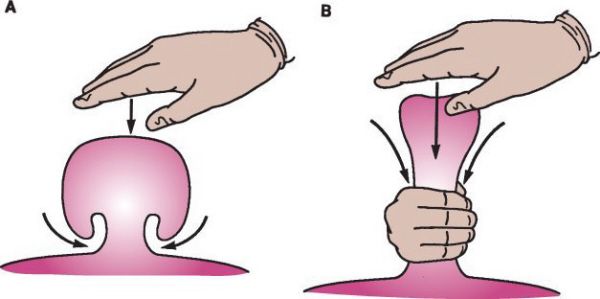
A 50-year-old man presenting with an asymptomatic inguinal hernia asks you about the risk of incarceration. What it the likelihood that his hernia will incarcerate?
10% of inguinal hernias and 20% of femoral hernias present incarcerated. Direct inguinal hernias generally have a wide-necked sac (unless they pass through the external ring), which lowers their risk of incarceration.

Left inguinal hernia. (With permission from Mulholland MW, Lillemoe KD, Doherty GM, Maier RV, Upchurch GR, eds. Greenfield’s Surgery. 4th ed. Philadelphia, PA: Lippincott Williams & Wilkins; 2005.)
Management of an Incarcerated Hernia
•If the hernia is incarcerated without signs of strangulation (fever, leukocytosis, worsening tenderness, or skin erythema), reduction at the bedside can be attempted
•If the hernia has signs of strangulation, emergent herniorrhaphy (hernia repair) is required
•Surgical mortality for a strangulated hernia with Child’s C cirrhosis can be up to 50%
•Vigorous attempts at reducing an incarcerated hernia with a small neck may lead to “en masse” reduction resulting in ongoing compromise of the entrapped bowel
When operating on incarcerated or strangulated hernias, open the hernia sac to inspect the viability of its contents.
A frail, 75-year-old man with multiple significant comorbidities has a minimally symptomatic right inguinal hernia. He is deemed to have a prohibitive surgical risk. What is your recommendation?
Non-operative management with a truss for symptomatic relief.
Hernia Truss
•Can provide symptomatic relief
•Correct measurement and fitting are important to prevent incarceration within the truss
•Hernia control in approximately 30% of patients
•Complications include testicular atrophy, ilioinguinal or femoral neuritis, and incarceration
A Truss should NOT be used for femoral hernias due to the high incidence of strangulation.
A 54-year-old female presents with an acute, painful, non-reducible bulge on the right anteromedial thigh, below the inguinal ligament. What is the most likely diagnosis?
An incarcerated, or non-reducible, femoral hernia should be considered.
Femoral Hernia
•5% of hernias overall
•Much more common in women
•Boundaries of the femoral canal:
•Inguinal ligament (anterior)
•Lacunar ligament (medial)
•Cooper ligament (posterior)
•Femoral vein (lateral)
•Surgical approach:
•Anterior infrainguinal (mesh-plug repair)
•Anterior inguinal (McVay repair)
•Posterior preperitoneal (laparoscopic repair)
•If a hernia is not reducible at exploration, the inguinal ligament can be divided
A 14-month-old boy presents to emergency room with an incarcerated right inguinal hernia. What is the next step in management?
Hernia reduction, hospital admission, and a semi-elective repair in the future.

Hernia reduction (A) applying pressure directly to neck occludes neck (B) elongating neck while applying pressure allows reduction. (With permission from Mulholland MW, Lillemoe KD, Doherty GM, Maier RV, Upchurch GR, eds. Greenfield’s Surgery. 4th ed. Philadelphia, PA: Lippincott Williams & Wilkins; 2005.)
Inguinal Hernia in Children
•High ligation and division of the hernia sac is indicated upon diagnosis
•Elective repair of reduced incarcerated hernias should be performed ASAP to avoid re-incarceration (16%)
•The incidence of developing a future contralateral inguinal hernia is 10% to 30%
A 2-month-old girl is noted to have a solid mass within an inguinal hernia. What is the most likely cause?
A normal ovary may present in an inguinal hernia sac in young girls. Beware of testicular feminization if the ovary appears abnormal or resembles a testicle (perform a biopsy and pelvic examination).
During an open repair of a right inguinal hernia, a bladder injury occurs. What was the most likely cause of the injury?
Failure to recognize the visceral component of a sliding hernia sac.
Stay updated, free articles. Join our Telegram channel

Full access? Get Clinical Tree


